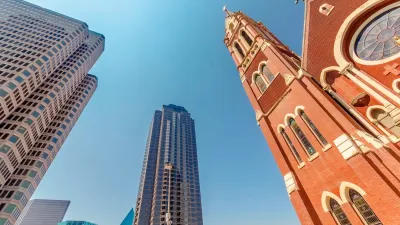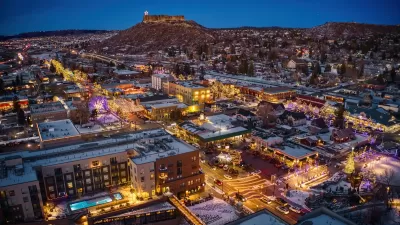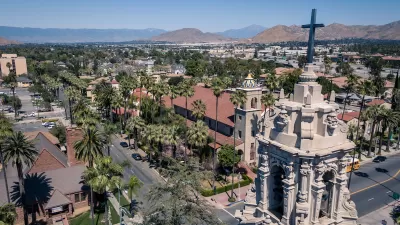In Washington, D.C., residents, shops and restaurants come and go, often moving from neighborhood to neighborhood. But churches remain. They anchor the community as it changes, and often find themselves changing with it.
When Dexter Nutall was growing up in the 1970s and 1980s, his family attended New Bethel Baptist Church in Shaw. “There was the corner store across the street when I was a kid,” Nutall remembers. “The whole Ninth Street area was not very active. There were very, very small operations.”
Now, Nutall—Reverend Nutall, now—is the pastor at New Bethel, and that’s not all that’s changed in 30 years.
The 1991 construction of the Shaw Metro Station, less than a block from the church, spurred development in the area. In the last few years, nearby townhouses have been renovated into pricey new apartments and condos, trendy restaurants and specialty food shops.
“A lot of change has taken place,” says Nutall, who became pastor five years ago, around the same time the neighborhood began its shift.
As D.C. develops, residents, shops and restaurants come and go, often moving from neighborhood to neighborhood. But churches remain. They anchor the community as it changes, and often find themselves changing with it.
Changing demographics
At New Bethel, change means the church has gotten bigger, with younger people and young families flooding in.
Even the racial makeup of the church has changed a little. “[New Bethel] historically is a traditional black Baptist church,” Nutall says. “That, I think, is changing to some degree.”
Nutall says new neighbors who aren’t African American have been coming in to check out the church, and some have become members. But the demographics of the church aren’t changing as quickly as the demographics of the community around it, he says.
Of course, the other side of bringing in new blood is that many longtime neighborhood residents have had to move away. “Because of gentrification and other forces that have forced people to leave this neighborhood, we have congregants that commute to the church,” Nutall says.
Congregants have long commuted to the National City Christian Church, which has sat on Thomas Circle since 1930, but as the neighborhood has developed, the church has begun to attract locals.
The neighborhood was once known for drugs and prostitution — until about ten years ago, when fancy apartment buildings popped up on the same block as National City. With them came wealthier, younger — and often whiter — residents. “It’s just changed the flavor of the neighborhood, for better or worse.” says Bill Knight, a church member of nineteen years who is now its facility administrator.
The church has always prided itself on diversity and openness (“We were doing gay wedding before gay weddings were legal,” Knight says), and Knight says the congregation has always been diverse in age, race, socio-economic status and sexual orientation. Some of those demographics have shifted since the development boom.
“We have seen more young white people here, but that’s just the nature of the neighborhood, “ he says. “But then again we’ve got some longstanding members of color that still come here.”
Despite mixed feelings about gentrification in the neighborhood, the influx of Millennials has had a rejuvenating effect on the church.
“We were an aging congregation before that,” Knight says. About ten years ago, a couple started a group for young adults at the church, and it’s now up to 60 or 70 members. “And out of that we’ve actually [done] two weddings,” Knight says proudly.
FULL STORY: DC's churches change with our changing city

Planetizen Federal Action Tracker
A weekly monitor of how Trump’s orders and actions are impacting planners and planning in America.

San Francisco's School District Spent $105M To Build Affordable Housing for Teachers — And That's Just the Beginning
SFUSD joins a growing list of school districts using their land holdings to address housing affordability challenges faced by their own employees.

The Tiny, Adorable $7,000 Car Turning Japan Onto EVs
The single seat Mibot charges from a regular plug as quickly as an iPad, and is about half the price of an average EV.

As Trump Phases Out FEMA, Is It Time to Flee the Floodplains?
With less federal funding available for disaster relief efforts, the need to relocate at-risk communities is more urgent than ever.

With Protected Lanes, 460% More People Commute by Bike
For those needing more ammo, more data proving what we already knew is here.

In More Metros Than You’d Think, Suburbs are Now More Expensive Than the City
If you're moving to the burbs to save on square footage, data shows you should think again.
Urban Design for Planners 1: Software Tools
This six-course series explores essential urban design concepts using open source software and equips planners with the tools they need to participate fully in the urban design process.
Planning for Universal Design
Learn the tools for implementing Universal Design in planning regulations.
Smith Gee Studio
City of Charlotte
City of Camden Redevelopment Agency
City of Astoria
Transportation Research & Education Center (TREC) at Portland State University
US High Speed Rail Association
City of Camden Redevelopment Agency
Municipality of Princeton (NJ)





























